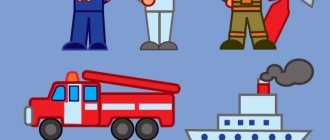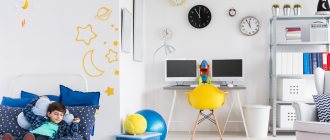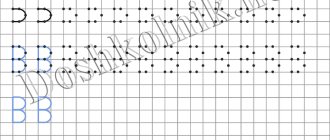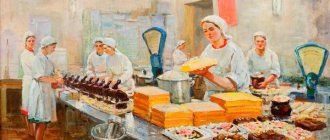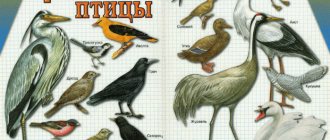Tambov-Viki Tambov-Viki
Goal: Clarification of knowledge about furniture, its purpose, development of logical thinking; attention, activation of vocabulary, education of the plural. noun, relative adj., exercise in the correct use of prepositions, noun. in space cases. Equipment: a set of pictures of furniture, pictures of a furniture factory, Shapoklyak toy. Progress of the lesson: 1.Org.moment: -Guys, look, two balloons have flown to us. Look at them. How are they different from each other? (one ball is happy and the other is sad). Which ball do you like best? Let's become like this balloon and smile at our guests and give them the warmth and kindness of our smiles. 2. Main part: Speech therapist: -Guys, look what the balls brought us. (an envelope containing pictures of furniture) The speech therapist opens the envelope and shows the children the pictures. How can all this be called in one word? (furniture) -Where is furniture made? -Who makes it? -What is furniture made from? -Why do we need furniture? Interactive game “Furniture Store” Children are presented with an empty room (bedroom) and a lot of different furniture. The child chooses the furniture that is intended for the bedroom and places it (using the mouse, wherever they want). During arrangement, he explains why this particular furniture is needed in this room. The next child needs to choose furniture for the living room, explaining the belonging of this furniture in this room. Find kitchen furniture; hallway, etc. D/i. "What is missing?" Speech therapist: - Crocodile Gena and Cheburashka bought furniture, but on the way Shapoklyak decided to play a trick on them and stole some furniture from them. -Look at the picture and tell me what they lack in the kitchen? (no table) -What's missing in the bedroom? -…………(Beds) In the hallway?……………….(Hangers) In the hall?…………(sofa, chairs) Physical education Speech therapist: -Guys, Tanya and Vanya have a parrot Kesha living in their room. But the cage accidentally opened and the parrot flew out of it. (the speech therapist places the parrot in different places, and the children say where the parrot is and where it flew out from. Above the closet from behind the chair Under the hanger from behind the table Behind the chair from under the table On the closet from under the chair Near the shelf Speech therapist: -Guys , look what I found. This is the furniture that Shapoklyak stole from Gena and Cheburashka's crocodiles. But what happened to it? (It's broken) -Can I use this kind of furniture?
Table without……..(legs) Chair without………(back) Chair without…….(seat) Wardrobe without…….(door)
-What needs to be done to make the furniture suitable? (repair)
Table……….(leg) Chair……….(seat, back) Armchair………(seat) Cabinet……….(doors)
Speech therapist: -Let's remember what you can sit on?
on …….. (chair) On ………(chair) On ……….(sofa) On………..(stool)
Bottom line: Guys, tell me what we can’t do without at night? (without a bed) -What can’t you do without while eating? (no table, no stool) This means that we need furniture both day and night.
Summary of an open lesson Speech development Topic: Furniture MIDDLE GROUP
Municipal preschool educational budgetary institution
“Kindergarten No. 28 “Scarlet Flower” combined type”
Open lesson summary
Speech development
Topic: Furniture
MIDDLE GROUP
Educator: Tokarenko T.S.
Minusinsk, 2021
Abstract of GCD for the middle group on the topic “Furniture”. Speech development.
Subject:
Furniture.
Target
: Clarification and expansion of ideas about furniture and its purpose, about its components.
Tasks:
Learn to understand the general word “furniture”; learn to form and use diminutive words in speech.
Develop coherent speech; ability to form complex sentences using the words “because” and “so that”; the ability to find and complete the missing piece of furniture; develop coordination of speech with movements; enrich children's vocabulary with new words: table top, dressing table.
Develop cooperation skills in games, independence, and initiative.
Materials:
toy furniture, a ball, a large toy car - a truck, object pictures, a doll, a marker, audio recordings, pictures of broken furniture.
Progress of the lesson.
1. Introductory part.
Sociogame “Smile to the right, smile to the left.” The teacher and the children form a circle, holding hands. Invites children, while pronouncing words, to perform head movements in accordance with the text.
Let's hold hands together and smile at each other,
Let's smile to the right, smile to the left.
Motivation
.The assistant turns on the audio recording. The doll is crying.
The teacher is surprised, then takes out a large car with a doll in it from the girls’ corner.
Educator.
What's happened? Why are you crying?
Doll
.
Guys, today I'm moving to a new house. And I don't know what to do. There are so many things. (The teacher lifts the blanket, under which there are doll pieces of furniture: table, chairs, bed, cabinet)
2. Main part.
Educator.
Guys, do you want to help the doll? Sit down on the carpet, let's discuss. What can we do first? Load the largest items onto the car. Right. Let me tell you some riddles, whoever guesses it will take the desired item and put it in our truck.
Puzzles.
There are four legs under the roof, and on the roof there is soup and spoons. (Table)
If you are tired of playing, then lie down on... (Bed)
There are hangers and shelves here, like there are floors in a house. Pants, blouses, T-shirts - everything is in order. (Closet)
You can sit on it if you are invited to the table to eat. (Chair)
Educator:
Well done guys, how can we call all these items in one word?
Children
: Furniture.
Educator.
What is furniture for? (
A bed is needed
to sleep on. A chair is needed to sit on it. A wardrobe is needed to store things in it. A table is needed to dine at it)
Doll.
Well done boys.
But can you help load this furniture? ( shows pictures)
Come to the table.
(Children come to the table, look at the pictures)
Game “Third Wheel” (at the table)
Educator
.
Guys, are all these items furniture? ( children's answers)
Let's figure it out.
Table, chair, samovar. What's missing here? Samovar - tableware.
Wardrobe, chair, ball. What's missing here? The ball is a toy.
Sofa, dressing table, hammer. What is unnecessary here? A hammer is a tool.
Bed, chest of drawers, car. What is unnecessary here? Car - transport.
Children choose an extra item, explaining their choice.
Doll.
Well done. We loaded all the furniture. Now, for our car to start, let's say the magic words.
Finger gymnastics.
We are moving now, taking everything with us.
(clench and unclench your fists alternately)
Chairs, table, sideboard, chest of drawers, will move with us
(alternately, rhythmically hit the palm with the fist, changing hands)
Here!
(cotton) - 2 times.
The assistant plays the “Sound of the Machine” audio recording.
Doll
.
Hurray guys, let's go! ( The car moves with the children to the chairs.)
Doll
. Well, here we are. Sit on the chairs. Look, while we were driving, some parts of the furniture broke off. What to do?
Educator.
Let's help the doll. Let's complete the missing part of the furniture.
Di.
“Complete the missing detail.” On the board are images of broken furniture: a chair without a leg, a wardrobe without handles, a table without a tabletop, a dressing table without a mirror.
Children complete the missing part of the furniture. Doll
. Thank you guys, you helped me a lot. Let's play now. I also have a ball. Stand in a circle. I will throw you a ball and name pieces of furniture, and you return it back, calling it affectionately.
A game. "Say kindly"
For example: sofa-sofa, wardrobe-locker, table-table, chair-chair, bed-crib, bedside table, armchair-chair, chest of drawers.
3. Final part.
Educator
: Please tell me, did we help the doll? How? What did you like most today? What new words did you learn today?
Doll
.
Now let's go celebrate the housewarming. (Children and the doll go to the girls’ corner and organize a story game)
Notes on cognitive development on the topic Furniture (senior group)
Abstract of educational activities on cognitive development with elements of research activities in the senior group on the topic: “Furniture”
Target:
activating children's knowledge about furniture; the material from which it is made.
Educational objectives:
activate nominative, predicative, attributive vocabulary on the topic “Furniture”. Learn to form and correctly use relative adjectives in speech, practice the formation of the plural form of the nominative case and the genitive case of nouns.
Developmental tasks:
develop the ability to compare, identify characteristics of objects, establish cause-and-effect relationships between objects and materials, generalize and draw conclusions. Develop mental operations of generalization and classification.
Educational tasks:
to develop skills of cooperation, a positive attitude towards participation in joint activities, initiative and independence. Cultivate a caring attitude towards household items
Equipment:
— Cards for the game “Fourth Odd.”
— Illustration “ancient people”.
— For educational and research activities: stones, boards, nails, hammer.
— Scheme: Stone - saw - nail with hammer - plane (all actions are crossed out). Wood - saw - nail with hammer - plane.
— Cut-out pictures (furniture).
— Scheme: one – many – none.
GCD move:
Organizing time.
Hello, golden sun! (Show the sun).
Hello, blue sky!
(Show the sky).
Hello, light breeze!
(Show “breeze”).
Hello, little oak tree!
(Show “oak tree”).
Hello, high chair! (Point to the chair).
Hello, table! (Point to the table).
Hello, guest, you have come to us! (Waving to guests).
Hello, Morning!
(Gesture to the right).
Hello Day!
( Gesture to the left
).
We are not too lazy to say hello!” ( Spread both arms to the sides
).
Main part.
By the time the guests arrived, we had put the family in order, but some items were out of place.
Exercise “4th extra”:
- Look carefully and name the extra object.
- slippers, sneakers, chair, shoes.
- cap, bed, hat, scarf.
- dress, T-shirt, wardrobe, trousers.
- jacket, overalls, coat, chair.
(Put the image of the extra item on the board).
— How can you call all these objects in one word? (Furniture)
Teacher's story, illustration:
— A long time ago, when there were no villages or cities, people lived in caves. To escape the rain and cold, they lit fires and warmed themselves by the fire.
What do you think people used to relax on? (On the grass, on the ground, on the stones).
- Think about whether it was convenient for them or not. Why was it uncomfortable? How did they feel? (Hard, uncomfortable).
The ancient people were uncomfortable, the earth was wet, cold, hard, the stones were sharp.
- If you lie in the cold for a long time, what happens? (You can freeze, catch a cold, get sick).
And then one day, the hunters, returning with their prey, sat down to rest on a fallen tree. Imagine that you are in the forest, sitting on a tree. Comfortable? Better than on earth?
It was then that the man began to think, what should he make furniture from? There were only rocks and trees around the cave.
- Let's examine and compare stones and wood (touch it, put it on your cheek, smell it).
Research activities.
- Touch the stone, tell us about it (hard, cold, heavy, uneven, rough, strong).
—
Touch the wood, tell us about it (
it’s pleasant to the touch, warm, strong, you can plan it and it will become smooth, you can drive a nail into it well, you can drill holes in it).
— Tell me, can a stone be cut? (No)
—Can you hammer a nail into a stone? (No)
—Can the stone be cut? (No)
— Let’s denote all these actions with the following diagram. (Show diagram)
—Can the tree be cut?
—Can you hammer a nail into a tree?
—Can the tree be cut?
— Let’s denote actions with a tree as follows. (Show diagram)
— Look at the diagrams and tell me, what is easier to make furniture from? Why?
Conclusion
: A person chose wood to make furniture because it is pleasant to the touch and can be processed well.
Later, furniture began to be made from other materials.
Exercise “What is furniture made of?” (in a circle)
wooden furniture – what kind? (wooden)
made of metal - which one? (metal)
made of plastic - which one? (plastic)
made of glass - which one? (glass)
We remembered what furniture is made of, and now we’ll build it ourselves.
Finger game "Furniture"
This is a chair - they sit on it ( the left palm in a fist is pressed against the right, fingers extended upward
).
This is a table - people sit at it ( the left hand is in a fist, the right open palm lies on top
)
Here is a bed - they are lying on it ( arms bent at the elbows in front of the chest, lying one on top of the other
)
We put things away in the closet ( imitation of folding things
)
We all go for a walk ( the fingers of both hands walk on the knees
)
In order for furniture to last longer, you need to take care of the furniture.
.
- How should this be done? (Wipe, wash, clean, repair, vacuum, knock out).
Cut pictures
(of four parts). Exercise “Name the parts of an object.”
Collect furniture items.
- What happened? (I got a chair, a wardrobe, an armchair)
- Name the parts of a chair, cabinet, armchair.
Game "One, many, no."
Talk about your subject using a diagram. (One - many - no).
Reflection.
— What do you remember most?
— What furniture would you choose for your apartment? Why?
— What did you especially like?
